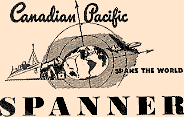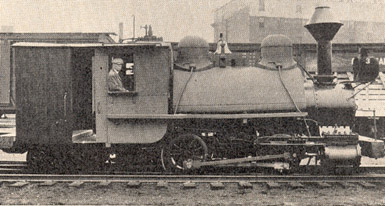
1947-1971
|

British Columbia
Pioneer
This is the third in a series of articles on
old-time locomotives prepared specially for Spanner by O.S.A.
Lavallee, office of the paymaster, Montreal. The articles are appearing at the
request of railway fans throughout the country.

This unit of
power affectionately known as "Curly" helped in the construction of
the first transcontinental rail line.
In 1870, British Columbia was admitted to Confederation as a
Province. The completion of the first transcontinental railway in the United
States in May, 1869 undoubtedly stimulated the imagination of the inhabitants of
Canada's Pacific seaboard to the extent that it was felt advisable to stipulate,
in one of the articles of the Province's admission, that a line of railway was to
be built to connect British Columbia with the older, eastern provinces, within
the ten years ensuing. Optimistic indeed were the promulgators of the provision
for a Canadian transcontinental railway, when it is considered that there was no
settlement west of the Red River, and no dependable surveys had been made, in
this barren region.
As a matter of fact, when the first contracts were let for commencement of
construction, under Government supervision, in the mid-Seventies,
no definite decision had been made as to which route would be taken through the
Rocky Mountains.
Political and financial vicissitudes resulted in the construction of but a few
hundred miles of railway in isolated sections, under the Government, and the
expiration of the ten year period in 1880 saw the dreamed-of
transcontinental far from achievement. In 1881, the Government's obvious
incapability to further this national necessity - given impetus by repeated
threats of secession from our westernmost province - found expression in the
incorporation of the Canadian Pacific Railway under private capital.
One of the sections of line completed under Government ownership extended for
212 miles inland from the Pacific Coast, up the Fraser and Thompson River
Canyons. The western terminus was at Port Moody, thirteen miles inland from the
site of present-day Vancouver, at the head of Burrard Inlet. Inland
end of the Pacific section was Savona's Ferry (now Savona) in the Thompson
Canyon, named after the native city of an Italian who operated a primitive ferry
across the turbulent Thompson. The construction of this section of line was
being exploited by a syndicate headed by Darius Ogden Mills. Mills had been
associated with other railway construction projects, notably the Virginia &
Truckee Railroad in the United States.
The contractor was Andrew Onderdonk. Due, probably, to D.O. Mills' connection to
that railway, most of the engines used by Onderdonk (there were nine in all)
came from the Virginia & Truckee.
Undoubtedly the best known of these locomotives, though not one of the
ex-V&T engines, was No. 2, the "Emory" which had been
built in San Francisco. Originally of the 0-4-0 wheel arrangement,
and having 14 x 20 inch cylinders and 42 inch driving wheels, this engine is
better known by its colloquial name "Curly" which was applied to it
while used in construction work.
"Emory", or "Curly" was landed at Emory, British Columbia,
near Yale, in the spring of 1881, this being the head of navigation (such as it
was) in the Fraser River at that time. When the Pacific section was handed over
to the C.P.R. for operation, the contractor's engines (which were not acquired by
the Company) remained in the Government's possession.
In 1888, "Curly" was sold to the Hastings Saw Mill Company and
continuing in the service of that company and its successors until 1926, it was
given honourable discharge by the B.C. Mills, Timber & Trading Company. The
engine was then reconditioned by the C.P.R. and presented to the Vancouver
Exhibition Association who have preserved it.
Contrary to the inscription on a plaque now borne by the engine, there is no
evidence that it was used by the French in construction work on the Panama Canal,
and it was not the first locomotive in British Columbia. Engine No. 1
"Yale", another Onderdonk engine, preceded "Curly" by six
months, and there were other engines used in mining work on Vancouver Island many
years previously. Before coming to Canada, "Curly" had been used in the
building of the great sea wall at San Francisco.
These facts notwithstanding, the tiny engine remains the embodiment of the
equipment with which our forefathers defied natural obstacles to complete
Canada's "National Highway".
Associated Links
Curly in later years
©
2005 William C. Slim
http://www.okthepk.ca
|
|
|

